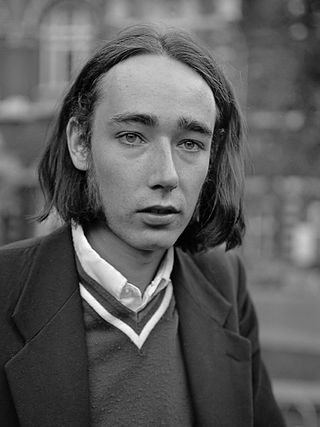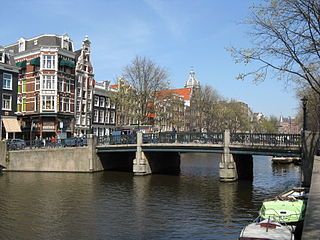
Amsterdam is the capital and most populous city of the Netherlands,with The Hague being the seat of government. It has a population of 921,402 within the city proper,1,457,018 in the urban area and 2,480,394 in the metropolitan area. Located in the Dutch province of North Holland,Amsterdam is colloquially referred to as the "Venice of the North",for its large number of canals,now designated a UNESCO World Heritage Site.

Vlaardingen is a city in South Holland in the Netherlands. It is located on the north bank of the Nieuwe Maas river at the confluence with the Oude Maas. The municipality administers an area of 26.69 km2 (10.31 sq mi),of which 23.57 km2 (9.10 sq mi) is land,with 73,924 residents in 2021.

Hoofddorp is the main town of the municipality of Haarlemmermeer,in the province of North Holland,the Netherlands. In 2021,the population was 77,885. The town was founded in 1853,immediately after the Haarlemmermeer had been drained.
Hack-Tic was a Dutch hacker magazine published between 1989 and 1994. It had a cult following and upset authorities beyond the Dutch borders.
Surinam Airways,also known by its initials SLM,is the flag carrier of Suriname,based in Paramaribo. It operates regional and long-haul scheduled passenger services. Its hub is at Johan Adolf Pengel International Airport (Zanderij). Surinam Airways is wholly owned by the Government of Suriname.

Willem Arnoldus Witsen was a Dutch painter and photographer associated with the Amsterdam Impressionism movement.

Wladimir "Wally" Tax was a Dutch singer and songwriter. He was founder and frontman of the Nederbeat group The Outsiders (1959–1969) and the rock group Tax Free (1969–1971).

The Waag is a 15th-century building on Nieuwmarkt square in Amsterdam. It was originally a city gate and part of the walls of Amsterdam. Later it served as a guildhall,museum,fire station and anatomical theatre,among other things.
The following is a timeline of the history of the municipality of Amsterdam,Netherlands.

Clara Gertrud Wichmann was a German–Dutch lawyer and anarchist feminist activist,who became a leading advocate of criminal justice reform and prison abolition in the Netherlands.
Melanie Bonajo (they/them) is a queer,non-binary,Dutch artist,filmmaker,feminist,sexological bodyworker,somatic sex coach and educator,cuddle workshop facilitator and animal rights activist. Through their videos,performances,photographs and installations,Mel examines current conundrums of co-existence in a crippling capitalistic systems,and address themes of eroding intimacy and isolation in an increasingly sterile,technological world.

The 2019 election to the Senate of the Netherlands was held on 27 May 2019,two months after the provincial elections.

The Geldersekade is a canal and a street in Amsterdam that connects the Nieuwmarkt with the Prins Hendrikkade. The Geldersekade is in the easternmost part of De Wallen,the red light district,and borders Chinatown.

The Oudeschans,or Oude Schans,originally the Nieuwe Gracht,is a wide canal in the eastern part of the inner city of Amsterdam.

Squatting in the Netherlands is the occupation of unused or derelict buildings or land without the permission of the owner. The modern squatters movement began in the 1960s in the Netherlands. By the 1980s,it had become a powerful anarchist social movement which regularly came into conflict with the state,particularly in Amsterdam with the Vondelstraat and coronation riots.

Renny Ramakers is a Dutch art historian,curator,design critic,and co-founder and director of the Droog design foundation. Ramakers writes articles,gives lectures,initiates projects and curates exhibitions in the field of art and design. In 2007 she was awarded the Benno Premsela Prize,in 2019 the IJprijs for her cultural contribution to the city of Amsterdam,and in 2018 she received a Dutch Royal Award for her work in the field of Dutch Design.
Mariecke van der Linden is a Dutch visual artist and opera composer. She works on music videos as an art director in the field of set design,costumes and styling. Furthermore she makes oil paintings and installations. Van der Linden is known for her portraits of prominent Dutch people such as Eberhard van der Laan,Johan Cruijff en Wubbo Ockels.

Pekel A (also Pekel Aa;Dutch pronunciation:[ˈpeːkəl aː]) is a river in the Province of Groningen in the Netherlands. The villages of Oude Pekela and Nieuwe Pekela have been named after the river. The name translates to Brine (Pekel) River (A),and used to flow from the Dollart into a large raised bog. The Dollart was poldered from the 15th century until 1924,and the river now has its source at the confluence with the Westerwoldsche Aa at De Bult. The river was canalised and extended. The part from Oude Pekela to Stadskanaal was renamed Pekelderdiep. From 1599 until 1810,the area through which the river flowed,was a peat colony. In the 20th century,the Pekel A was a heavily polluted river,but it has been cleaned up since the 1970s.













